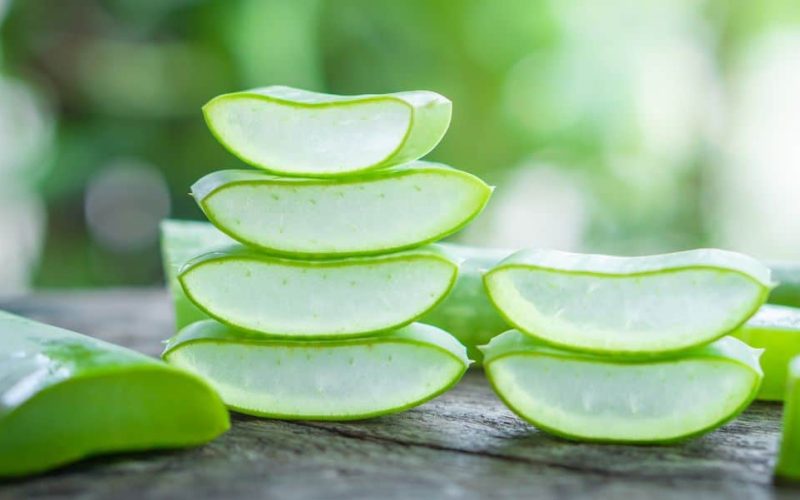Aloe vera is a common plant grown in various parts of the world and can serve many purposes.
However, many people don’t know they can eat the delicious plant. This article will discuss the plant, how to eat aloe vera and other unique uses.
What is Aloe Vera?
Aloe Vera is a short-stemmed shrub that grows 29-39 inches tall and spreads naturally and asexually.
Its leaves are fleshy and substantial, ranging from a light shade of green to a darker shade.
It is originally from the Arabian Peninsula but grows wild in arid and tropical weather around the globe. It is an attractive species that is used as an ornamental and as an indoor potted plant.
Aloe vera has often been referred to as an ‘immortality plant’ because of its ability to survive without soil. It is a family member of Asphodelaceae, which has over 400 aloe species.
Can You Eat Aloe Vera?
Many people wonder if this plant is safe for consumption. The answer is yes. Aloe vera is generally safe to eat.
The plant’s leaves consist of three parts:
- The skin
- The gel
- The latex
The skin is the green outer part of the plant, while the gel is the unclouded jelly-like substance found inside the plant leaf. The latex, a yellow-colored substance, comes from underneath the plant skin.
It is mainly known for its gel, which is good to eat when correctly prepared. Additionally, the skin is very safe to consume.
It has an incredible flavor and a crunchy texture suitable for salads. In contrast, consuming too much latex can have fatal side effects.
Though it contains laxative properties, it is not advisable to ingest it orally. Pregnant or breastfeeding women should avoid eating aloe vera as it contains a stimulant that causes uterus contraction.
The plant includes a laxative that is unhealthy for pregnant women. People with intestinal conditions should not eat aloe vera.
Experts have also warned that children under twelve should take it in moderation. This is because aloe vera can cause stomach pain and diarrhea.
How to Eat Aloe Vera?
To prepare the skin, remove the spiky part alongside the leaves and slice the flat side of the skin. Then, wash it thoroughly to remove dirt and debris.
It is advisable to soak it in water for 15-20 minutes to soften it before eating. It can be sliced in salads or eaten with salsa.
To prepare the gel, cut off the spiky edges and slice off the skin. Remove the gel and chop it into cubes. Wash the cubes to remove traces of latex, as its residue gives the gel an unpleasant taste.
Removing unknown leaves attached to your aloe vera is vital as they may be poisonous.
Uses of Aloe Vera
- Treatment of constipation: Aloe vera, a natural laxative, has been proven to relieve constipation and aid digestion. However, it would help if you used it sparingly.
- Skincare: Aloe vera gel moisturizes skin and reduces inflammation. It contains healthy nutrients that fight bacteria, nourish, and keep the skin hydrated.
- Alternative mouthwash: In 2014, a study in the Ethiopian Journal of Health Services specified aloe vera extract as an adequate substitute for chemical mouthwash. The plant, which contains vitamins, can block plaque, relieve swollen gums, and stop bleeding.
- Treatment of heartburn: In 2010, a review suggested that taking 2-3 ounces of aloe gel reduces the intensity of Gastroesophageal reflux disease. Its low toxicity makes it a gentle solution for heartburn.
- Preservation of produce: Coating fruits and vegetables with aloe gel keeps them fresh by preventing unhealthy bacteria growth.
Heath Benefits of Aloe Vera
Knowing how to eat aloe vera is essential, as are its health benefits.
They include;
- It contains healthy plant compounds. Pharmaceutical, cosmetic, and food companies use aloe vera gel to make products. This is because of the gel’s vitamin, amino acid, and antioxidant content.
- For wound treatment: You can use the gel to treat sores and sunburn. It hastens the healing process of wounds.
- It has antioxidant properties. Aloe gel contains polyphenols, which reduce material growth in humans when mixed with other compounds.
- Preventing wrinkles: Studies have shown that oral aloe vera gel increases collagen production and improves skin elasticity.
- Treatment of mouth ulcers: Aloe vera gel, with its high mineral content, is a good treatment for canker sores. These sores, which often form under the lip or inside the mouth, can be healed with aloe vera in seven days.
- It reduces dental problems: Dental diseases are common health problems. Aloe vera mouthwash has proven to be very effective in reducing dental plaque.
Side Effects of Aloe Vera
Though therapeutic, aloe vera has its downsides, and some common side effects include:
- Stomach cramps can happen when you take the plant’s gel in high doses.
- Skin burn: For some people, aloe vera gel applied to the skin could cause irritation or slight burning. Don’t use it directly on infected skin.
- Muscle weakness and weight loss: This is caused by long-term use of high doses.
- Liver problems: Liver problems are rare, but studies have shown that too much oral intake of aloe vera could cause liver problems.
Summary
Aloe vera has various medicinal properties. It can be used as skin ointments and tooth treatment. It can also be used directly or processed in bottles.
Nonetheless, always seek the doctor’s permission before using aloe vera to treat a condition.








